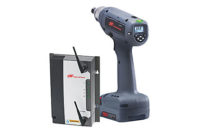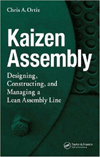Tabletop robots, error-proof fastening tools and a manufacturing app for the Google Glass were among the myriad new technologies that dazzled manufacturing engineers and managers attending the second annual ASSEMBLY Show.
Some 205 technology suppliers—55 more than last year’s event—exhibited at the show, which was held Oct. 28-30 at the Donald E. Stephens Convention Center in Rosemont, IL. The exhibits spanned more than 50,000 net square feet, a 41 percent increase over 2013.
Nearly 3,800 manufacturing and design professionals visited the event, a 33 percent increase over last year’s attendance. (More than 6,300 engineers and managers registered for the show, a 36 percent increase compared with 2103.)
Many exhibitors deemed the show a huge success. “We had a great show,” said Phil Sponslor, president of Orbitform. “The attendees were plentiful, interested and motivated. We had five times as many leads as we had last year.”
“We were pleased last year, and this year was even better,” added Glenn Nausley, president of Promess Inc.
The show was such a success that 72 percent of the 2014 exhibitors have already renewed their booth space for the 2015 show, which will take place Oct. 27-29 back in Rosemont.
Attendees were predominantly from the greater Midwest, but manufacturing professionals came from as far west as Washington and California, as far south as Texas and Florida, and as far east as Connecticut and Rhode Island. The show also drew international attendance, including representatives from Canada, Mexico, Greece, Japan and the United Arab Emirates.
Manufacturers from every major industry covered by ASSEMBLY were represented in the throng, including automotive (Borg Warner, Chrysler, Honda, etc.); aerospace (Augusta Westland, Boeing, Sikorsky, etc.); appliances and electrical equipment (Cree, Whirlpool, Insinkerator, etc.), computers and electronics (Bose, Flextronics, etc.), medical devices (Abbott Laboratories, Becton Dickinson, Baxter, etc.); machinery (Briggs & Stratton, Deere, Caterpillar, etc.), consumer products (BIC, Hasbro, etc.); and fabricated metal products (Delta Faucet, Sloan Valve, etc.).
“We are thrilled with the response from the industry and thank the exhibitors, attendees, speakers and press who made this such a worthwhile event,” said Tom Esposito, publisher of ASSEMBLY Magazine. “The event was robust with the new products, services and technologies available to the industry today. This was a clear representation of the growth of the overall industry.”
The show offered numerous opportunities to become better connected, better prepared and better informed. Besides the keynote address, the conference program included two three-hour workshops and 11 educational sessions that were held in theaters set up on the show floor. Many of the presentations, including the keynote, were broadcast live, and all of the recordings are available on www.theassemblyshow.com.
The sessions covered topics ranging from power tool ergonomics to high-speed automated assembly. Presentations were given by Panasonic Assembly Tools, Desoutter Industrial Tools, SCHUNK Inc., Henkel Corp., Transformix Engineering Inc., Banner Engineering, 3M Industrial Adhesives and Tapes, The Arthur G. Russell Co., Ingersoll Rand Power Tools, and the Robotics Industries Association.
In addition, John Sprovieri, editor in chief of ASSEMBLY, unveiled the results of the magazine’s 19th annual Capital Equipment Spending Survey.
“U.S. manufacturing is doing very well right now,” he said. “Manufacturing employment is at its highest level since April 2010, and manufacturing operations are running at 77 percent capacity.
“Manufacturers will continue to invest in people, plants and equipment next year. Seventy-five percent of plants will spend at least the same if not more on assembly technology next year than they did this year.”
Workshop Covers Plastics Assembly
The show began Oct. 28 with two workshops that were held just prior to the opening of the show floor.
One workshop was devoted to various methods for assembling plastic parts. When considering the best method for assembling plastic parts, engineers should endeavor to be process-neutral and to involve potential suppliers early in the design phase.
That was a common theme cited by each of four industry experts who shared their expertise during the three-hour workshop. More than 50 engineers turned out for the workshop, which included presentations on hot-plate welding, snap-fit assembly and threaded inserts.
“Let the application guide you to the best assembly method,” advised Jeff Frantz, director of ultrasonic business development for Branson Ultrasonics Corp. Engineers should consider the materials; the size and shape of the parts; strength and functional requirements; production volume; cosmetics; and other factors when choosing an assembly method.
Material factors can make a big difference in the success of the assembly. For example, pigments can change the material characteristics of a plastic, pointed out Paul Tres, author of the textbook Designing Plastics Parts for Assembly. “That’s important, because the performance specifications provided by plastics manufacturers are only for unpigmented materials,” he said. “You need to test how your material will work in the assembly.”
Engineers Learn DFMA
Some 136 engineers attended a workshop on design for manufacture and assembly (DFMA) at The ASSEMBLY Show.
A panel of leading experts organized by Boothroyd Dewhurst Inc. examined some of the issues, trends and challenges that manufacturers face when implementing DFMA. They also explained how to reduce the cost of product design and development.
DFMA is a suite of software tools used to analyze and understand the cost of a product’s design and its constituent parts.
At least 85 percent of manufacturing costs are determined in the early stages of design. When engineers make informed design decisions during the concept stage, they can avoid costly corrections later on.
“It’s all about the parts count. Fewer parts mean there’s less cost for the product,” said Brian Rapoza, director of engineering at Boothroyd Dewhurst. “It is essential that cost is considered, because 72 percent of the typical product consists of parts cost. Overhead represents 24 percent of product costs, while assembly labor is only 4 percent.”
“DFMA is the best tool in the engineer’s tool box,” added Nicholas Dewhurst, executive vice president of Boothroyd Dewhurst. “Anything you can do to reduce parts count is a good thing. Any part that fastens, secures or connects is always a candidate for elimination.”
During the three-hour workshop, Chris Tsai, director of DFMA implementation services at Boothroyd Dewhurst, recalled his prior experience working as an engineer at Eastman Kodak Co. In the 1980s and 1990s, Tsai and his colleagues used DFMA to conduct function-based competitive product design analysis of digital cameras.
Matthew Miles, DFMA and value engineering manager at Dynisco Instruments LLC, wrapped up the workshop by explaining how his company uses DFMA to improve purchase price variance within the supply chain. Dynisco’s data-driven approach engages suppliers in product design reviews and discussions, resulting in a clearer understanding of what parts and materials cost.
It’s Gotta be the Shoes
The ASSEMBLY Show kicked off with a thought-provoking keynote speech by Tim Hutzel and David Lippert, co-authors of Bringing Jobs Back to the USA: Rebuilding America’s Manufacturing through Reshoring.
The address began with audience members taking off their shoes. “Take a look to see where your shoes were made,” asked Lippert, president of Hamilton Caster & Manufacturing Co.
Only one person in the capacity crowd 273 manufacturing engineers and managers could boast that he was wearing shoes that were made in the USA.
The speakers’ book, like their presentation, was intended as a wake-up call to U.S. manufacturers about the dangers of offshoring and the benefits of reshoring.
“If you’re selling a product in the United States, why would you make that product more than 6,200 miles away in China?” asked Hutzel, a lean consultant and former manufacturing manager with General Electric. “Who could think that was a good idea?”
Preceding the keynote Austin Weber, senior editor for ASSEMBLY Magazine, presented the Assembly Plant of the Year Award to STIHL Inc., a leading manufacturer of outdoor power equipment. The company’s state-of-the-art vertically integrated factory in Virginia Beach, VA, won the award for its innovative use of automation to reduce cost and increase value.
“At STIHL, we always seek out new strategies and technologies to reduce production cost and time, better our products for our loyal customers, and enhance the work environment for our employees,” said Christian Koestler, vice president of operations at STIHL. “Being honored as the 2014 Assembly Plant of the Year is a testament to the success of the STIHL way.”
Senior Editor Weber Tries the Google Glass
In a recent ASSEMBLY article entitled “Paperless Production,” I noted that emerging wearable technology will allow manufacturers to enter a new dimension. I had an opportunity to experience that firsthand when I tried on a Google Glass at the eFlex Systems booth. As I scanned QR codes and saw real-time images “floating” a few inches in front of my eyes, the demo convinced me that we’ll see more hands-free technology on assembly lines in the near future.
The eFlex SmartGlass promises “a production line without laptops and industrial kiosks.” It took me a few minutes to learn how to use and interact with the device, but the experience left me intrigued by the possibilities of wearable devices.
Another product that I wrote about earlier this year and had a chance to see up close in Rosemont was the paperless work instruction software from Visual Knowledge Share Ltd. The visual knowledge share system provides a variety of productivity tracking, operator accountability, traceability and quality checklist features.
It also allows engineers to integrate work instructions with key performance indicators. Another cool feature is adaptive technology that connects with machines and tools, and automatically advances work instructions to the next step as various assembly steps are performed.
Before the show began, I stopped by the SUS Corp. booth and talked to the company’s president, Yasuo Ishida, who was visiting from Japan. The 22-year-old firm recently established a U.S. office to market its innovative line of structural framing products.
Ishida told me about the lean manufacturing concept of “karakuri,” a Japanese word that means producing work with little energy input and no motors or drives. The SUS aluminum framing system incorporates pulleys, levers, foot pedals, counterweights and other simple devices that harness gravity to move parts bins and components forward. In addition, SUS unveiled a line of GreenFrame products that are fully recyclable and 40 percent lighter than plastic-coated steel pipes.
Another cool product that I saw in Rosemont was the new 3520 leak tester at the Sciemetric Instruments booth. The device boasts high accuracy and fast cycle times. Thanks to advanced electronics and sensors, test data is displayed in a visual manner that supports rapid decision-making and process improvement.
I was also intrigued by a “power cart” displayed at the Worksmart Systems Inc. booth. The six-wheeled, height-adjustable Fleximate provides manufacturers with a way to easily reconfigure assembly lines. By following a magnetic strip on the floor, it allows engineers to design flexible, barrier-free assembly lines. Designed to handle heavy assemblies, the cart complements modular workstations and flow racks.
—Austin Weber













